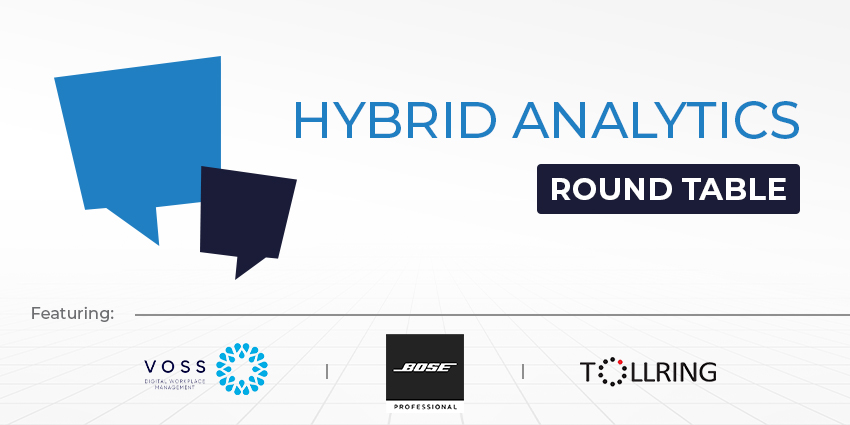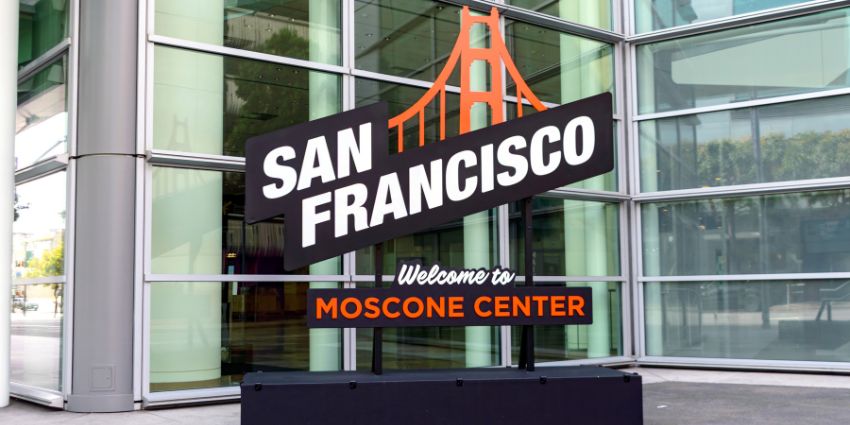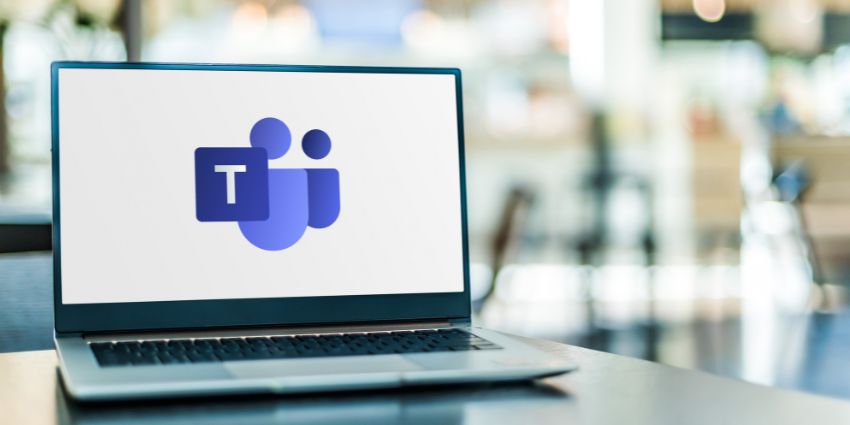Hybrid work is here to stay. Recent research by insurance broking and risk management firm Gallagher found that over two-thirds of UK businesses have introduced hybrid working because of employee demand for greater working flexibility (69 percent). Meanwhile, three-fifths said they wished they had a hybrid model pre-pandemic because it’s been such a success, with three-quarters saying employees have improved their efficiency.
Yet, while the benefits of hybrid working for employee productivity and well-being are well-documented, there are still ways that businesses can maximise the value of their hybrid working model. They can introduce metrics and KPIs to measure the model’s success and leverage employee feedback to inform what works from their perspectives. Hybrid analytics will be invaluable for building a productive and fulfilling future of work.
With our latest Round Table subject, “Hybrid Analytics “, we spoke with experts and executives from Bose Professional, Tollring and VOSS Analytics about the key KPIs to track the success of hybrid work, the challenges in optimising hybrid working, best practices and gathering and analysing employee feedback, and emerging trends in hybrid technologies.
What are the key hybrid work metrics and KPIs to track and assess the success of this model?

Adam Shulman, Product Lead, Installed Systems Business at Bose Professional
Shulman argued that metrics in 2023 tend to fall into two categories: “Occupancy tracking, also known as conference room utilisation rate, which measures the percentage of time the space is occupied, and utilisation tracking of the in-room technology and whether it’s being used.”
Shulman outlined that these meeting room metrics are distinguished from other workspace metrics. They offer insight into how regularly the space is used, who’s using the room, the average number of people per meeting, and what technology is preferred.
“With a target utilisation rate of 40-60% of the normal workday, these metrics — along with any IT support requests — provide a complete picture of what is happening in the room,” Shulman explained.
“These metrics make it possible to confirm if the occupancy rate matches what was forecasted, and if not, the utilisation data can provide potential areas of improvement to ensure an organisation gains the most from their hybrid work investment.”
Tim Jalland, Solution Manager at VOSS Solutions
Jalland outlined three core areas to focus on when assessing the success of a hybrid work model.
The first is user experience and adoption, which involves having to “gauge employee productivity and effectiveness in various work settings (office, remote), collect feedback from users regarding their experiences with the hybrid model, and evaluate their ability to collaborate effectively within the digital workplace”.
The second core area Jalland suggested is service readiness and environmental. This entails proactively monitoring the performance and dependability of the collaboration platform and making sure the platform is accessible, secure and widely available so employees can use it when and where they need to. Lastly, the core area involves ” assessing the availability of essential services, like document sharing, chat, video, and meeting capabilities”.
The final core area is economics, which Jalland described as being able to “track and manage costs associated with the hybrid work model, strive for cost-efficiency while maintaining high productivity, and optimise the utilisation of assets and resources in a balanced manner without over-committing capacity, licensing, costs”.
Hilary Oliver, Chief Marketing and Experience Officer at Tollring
Oliver said that one of the fundamentals for a successful hybrid working model is that every organisation and every department needs to understand what best practice looks like. “By creating an optimal working profile for their specific team, it is possible to identify the metrics to measure and review,” Oliver elaborated.
“For hybrid working, good communication and collaboration are the drivers rather than the by-products of strong performance and productivity. However, many people are unaware they can leverage this type of data from Microsoft Teams.”
Oliver highlighted that this process was what Tollring’s customer Osotspa succeeded with using its Analytics 365 app. Osotspa reviewed their hybrid working policy through Analytics 365 to understand working patterns and behaviours when using Microsoft Teams. The service also helped them define best practices and prove that their business did not suffer because of hybrid working.
Oliver also suggested that because managing people in a hybrid context can be difficult, understanding trends and working habits can offer support to managers. “By reviewing the communication habits of the most successful individuals or teams, managers can determine and encourage an optimal balance of collaboration per working day/week across different roles by reviewing time spent in scheduled/recurring meetings and the percentage of internal versus external engagement,” she said.
“The data from Teams can also help identify management styles through analysis of one-to-one and group meetings with direct reports and, indeed, their own manager,” Oliver continued.
What are common challenges in optimising a successful hybrid working model, and how should organisations go about addressing them using analytics?

Hilary Oliver, Chief Marketing and Experience Officer at Tollring
Oliver identified that the biggest challenge for a successful hybrid model is that different teams and roles will likely have additional requirements.
“Organisations should start with what best practice looks like before looking at the numbers,” she said. “As an example, it could be that using video on calls is considered critical to building relationships both internally and externally.
“However, for certain teams, such as technical developers, using video may be less important, and interaction using chat may be encouraged as a higher priority – facilitating quick Q&A, instant answers and continuous alignment on projects,” Oliver continued. “Managers need to be equipped with relevant analytics which can be applied in an intelligent and objective way.”
Tim Jalland, Solution Manager at VOSS Solutions
Jalland suggested that organisations need effective productivity measures and return on investment (ROI) assurance in today’s dynamic work landscape. Managing this complex technology ecosystem also introduces significant hurdles.
“UC analytics to the rescue,” Jalland explained. “It tracks productivity, benchmarks performance, and evaluates employee effectiveness. It also offers insights into technology performance, facilitating informed decisions on resource allocation and tech investments.”
“Transitioning to new technologies and tools requires adaptation and learning for employees,” he added. “Analytics help here, too. By tracking user adoption, enabling tailored support and training programs for smooth integration.”
Jalland also highlighted that the shift to remote work could prompt security and compliance concerns. “Analytics monitors and detects security threats and compliance issues, ensuring data safety,” Jalland elaborated.
Finally, balancing costs during a cloud transition while sustaining existing infrastructure will continue to be an ongoing challenge, but to address these issues, “analytics provides data-driven insights for cost management, optimising spending and assessing ROI”.
“In essence, tackling hybrid working challenges relies on analytics,” Jalland summarised. “It captures, normalises, and presents data in alignment with business goals, empowering informed decisions in pursuit of productivity, efficiency, and cost-effectiveness.”
How do you gather and analyse employee feedback to gauge their satisfaction, well-being and engagement in hybrid work scenarios?
Tim Jalland, Solution Manager at VOSS Solutions

For Jalland, the best practice for gathering and analysing employee feedback involves collecting data from different sources like digital communication tools, surveys, and direct employee input.
“The data is then correlated to offer a comprehensive understanding of the situation, enabling organisations to track trends and make informed decisions on improvements measured quarter by quarter,” Jalland said.
Jalland stressed that this analysis identifies hotspots that require attention, whether it’s underutilised meeting rooms, over-equipped locations, or sites lacking critical facilities. “By addressing these issues, organisations can continually enhance employee satisfaction, well-being, and engagement in their hybrid work scenarios,” he added.
Adam Shulman, Product Lead, Installed Systems Business at Bose Professional
For Shulman, user feedback is essential for developing valuable meeting spaces, especially in a hybrid work environment.
“Regular formal surveys to employees help to build a benchmark, and when used with a ‘real-time’ feedback option — like an instant survey after a meeting has ended — will keep feedback timely and enable users to provide more details,” Shulman explained.
“By removing any barriers to submitting meeting room feedback (and acting on feedback), it helps to refine the meeting room experience and reinforce that the spaces are an important part of everyday business and are viewed as a valuable work resource,” he continued.
Hilary Oliver, Chief Marketing and Experience Officer at Tollring
Oliver outlined a process of gathering and analysing qualitative feedback from employee satisfaction and pulse surveys but also highlighted the importance of standardising questions in performance reviews and incorporating quantitative data using analytics from Microsoft Teams to provide a more rounded view — especially in a hybrid work scenario.
“Where Microsoft Teams is in play, collaborative engagement data can be used in conjunction with the ‘of the moment’ satisfaction and well-being feedback,” Oliver expanded. “As an example, a manager may identify that 95 percent of a team member’s time is in scheduled meetings, with 80 percent recurring. This kind of data can help raise questions such as if the individual has enough time to do their work and if it impacts their well-being.”
“Working habits, collaboration trends and day-to-day working practices can significantly impact well-being but may not be recognised as factors to raise on a well-being survey,” she continued. “Analytics from Microsoft Teams can highlight contributing factors to a dip or spike in well-being and empower managers to open discussions in a more meaningful way.”
These types of analytics can expand conversations based on a deeper understanding of that employee in their hybrid working world. “But it’s only the manager who can interpret that data in a way that is meaningful because they understand the role and the individual involved,” Oliver clarified. “The data doesn’t judge but rather brings conversations to the surface.”
“In another example, the analytics might reveal that an individual always used video for group calls in the past but now only uses video for their one-to-ones. It helps the manager to ask relevant questions that wouldn’t be possible without the analytics.”
What emerging trends or technologies do you see in hybrid work analytics, and how should organisations prepare for these changes?
Hilary Oliver, Chief Marketing and Experience Officer at Tollring
Oliver underlined Microsoft’s constant evolution and how its Operator Connect technology will “further transform hybrid working”. “Users are able to answer a mobile call and uplift it to Teams,” she added. “Analytics will deliver an even more accurate profile of how a person is working and enable managers to deliver even better support.”
Oliver stressed that the future trend will be in delivering insights rather than raw data. “From our heritage in telecoms analytics, our focus is on getting the right information to the right people at the right time without them having to search for it,” she continued. “A key benefit of Analytics 365 is its visual dashboards that present insights to the user without them having to be a data scientist.”
However, Oliver caveated that it is still early days for the technology and compelled organisations to be clear on what hybrid working means for their organisation. Organisations must instruct managers on best practices for hybrid workers and provide them with the necessary tools.
“The aim is to have a culture of transparency and people supporting each other to be the best versions of themselves,” Oliver said. “You can’t do that without an objective data set that is applied in the context of your organisation.”
Tim Jalland, Solution Manager at VOSS Solutions
Jalland identified several emerging trends and technologies that are coming to the forefront.
Firstly, Jalland said automation “plays a pivotal role in swiftly and efficiently configuring platforms and facilities to cater to the ever-evolving needs of the hybrid workforce, extending its reach beyond employees to encompass external participants”.
The second trend is the need for insights via a single comprehensive window through the central collaboration platform. “This entails ensuring that the platform not only enhances productivity and innovation but also optimises resource utilisation and cost reduction,” Jalland continued.
Jalland’s final trend is improved analytics, which he described as “covering aspects ranging from building management to meeting room facilities, (and) offers a more extensive and transparent view of the hybrid workplace”.
“To prepare for these changes, organisations should carry out a thorough discovery and audit process to establish a baseline for planning and then proceed with resource rationalisation to allocate funds effectively, particularly in the digital workplace, thus prioritising UC cost analytics,” Jalland concluded.
Adam Shulman, Product Lead, Installed Systems Business at Bose Professional
For Shulman, emerging trends like AI and machine learning shouldn’t necessarily change the metrics or KPIs the tech sector is collecting for hybrid work, but they will likely influence what that data says.
“As the UCs (such as Microsoft and Zoom) adopt and expand the use of these new technologies in their products, we will likely see new useful features – such as multi-language translation, automated note-taking, and even audio and video effects,” Shulman said. “Recently, I saw a new product that corrects your image so that it appears you are looking at the camera directly even if you are looking at your screen slightly off-camera; it does not yet do this in real time, however.
As these technologies are rolled out, Shulman warns that businesses should watch their metrics carefully to understand their impact on meeting productivity. “In some cases, perhaps these technologies can actually add new metrics – such as measuring engagement by watching where meeting participants are looking and to whom they are speaking,” he said.
“We have already seen early evidence of this in features such as ‘Speaker Coach’ in Microsoft Teams, which analyses your speech, use of filler words, pace, time speaking versus listening, and provides real-time feedback to you while in a meeting,” Shulman elaborated.








